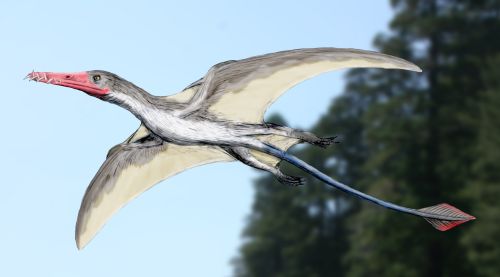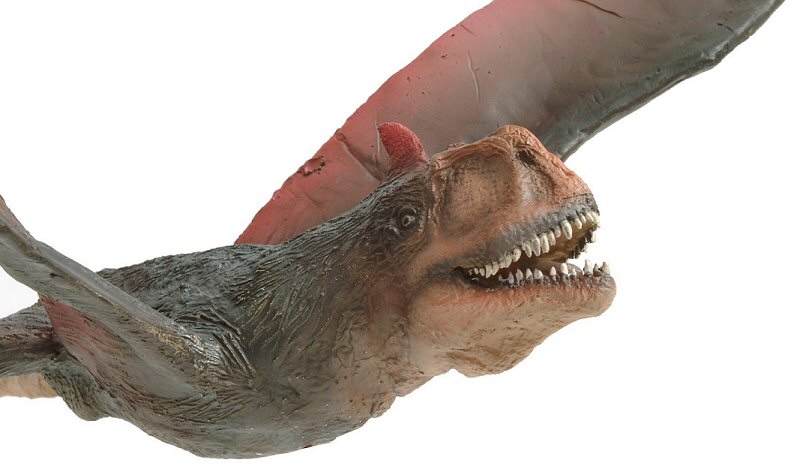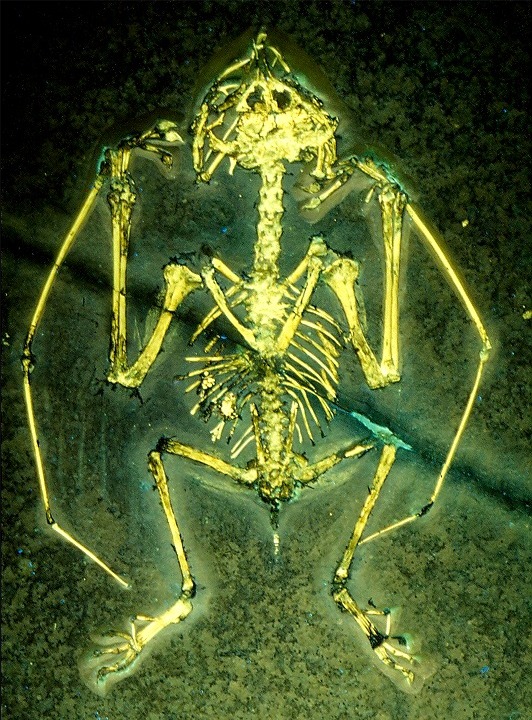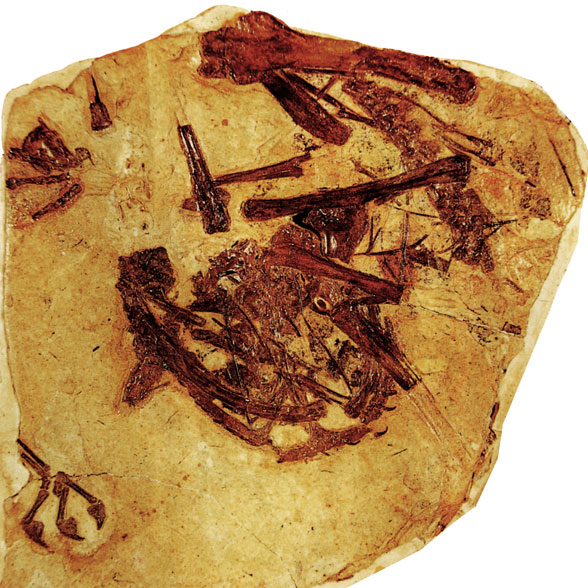[Recent Entries][Archive][Friends][User Info]
May 9th, 2012
| May 9th, 2012 | |
|---|---|
| 03:07 pm [industrialterro] [Link] |
Angustinaripterus Angustinaripterus was a basal pterosaur, belonging to the Breviquartossa, and discovered at Dashanpu near Zigong in the Szechuan province of China. Angustinaripterus was named in 1983 by He Xinlu. The type species is Angustinaripterus longicephalus. The genus name is derived from Latin angustus, "narrow" and naris, "nostril", combined with Latinized Greek pteron, "wing". The specific name is derived from Latin longus, "long", and Greek kephale, "head". The holotype, ZDM T8001, is a single skull with lower jaws, found in 1981 by researchers from the Zigong Historical Museum of the Salt Industry, in the Xiaximiao Formation (Bathonian). The skull, of which the left side is severely damaged, is very elongated and flat. The back part is missing; in its conserved state it has a length of 192 millimetres; the total length in a complete state was estimated at 201 millimetres. On its top is a low crest, two to three millimetres high. The nares are long, slit-like and positioned above and in front of the large skull openings, the fenestrae antorbitales, with which they are not confluent. Of the jaws, which are very straight, the front part is lacking. There are six pairs of teeth in the maxillae and three pairs in the praemaxillae. In the mandible there are at least ten pairs of teeth, perhaps twelve. The back teeth are small, the front teeth are very long, robust and curved, pointing moderately forwards. At the front they form a large, intermeshing "prey grab", that may have been used to snatch fish from the water surface. The teeth of Angustinaripterus resemble those of Dorygnathus. He placed Angustinaripterus into the Rhamphorhynchidae. Because of the derived morphology and the large geographical distance with comparable European forms He also created a special subfamily Angustinaripterinae, of which Angustinaripterus itself is the only known member; because of this redundancy the concept is rarely used. He concluded that Angustinaripterus was directly related to the Scaphognathinae. David Unwin however, considers it a member of the other rhamphorhynchid subgroup: the Rhamphorhynchinae. Peter Wellnhofer in 1991, assuming the skull length was 16.5 centimetres, estimated the wingspan at 1.6 metres.
Tags: Вымершие рептилии, Юра, авеметатарзалии, архозавроморфы, архозавры, диапсиды, птерозавры, рамфоринхиды, рамфоринхоидеи |
| Time | Event |
| 03:23 pm [industrialterro] [Link] |
Anurognathus Анурогнат (Anurognathus от греч. αν — без, греч. оυρα — хвост и греч. γναθος — челюсти) — род малых птерозавров семейства Anurognathidae, представители которого жили около 150 миллионов лет назад в конце юрского периода. Род был описан и назван Людвигом Дёдерляйном (Ludwig Döderlein) в 1923 году. Типовым видом является Anurognathus ammoni. Представители рода отличаются необычной внешностью по отношению к другим птерозаврам подотряда Рамфоринхоиды. Видовое название ammoni дано в честь баварского геолога Людвига фон Аммона, который собрал коллекцию ископаемых, в которой был и Anurognathus ammoni. Анурогнат означает буквально «бесхвостый» или «беззубый» — что ж, вполне понятная, хотя и не совсем точная характеристика применительно к этим необычным птерозаврам. Судить об анурогнатах ученым остаётся только по останкам одной-единственной особи, обнаруженной в Германии в 20-е годы XX века. Хвост у него и правда походил на обрубок, голова была маленькая и тупорылая, а в пасти имелось всего несколько мелких зубов. Зато анурогнаты обладали хорошо развитыми конечностями. Впрочем, наличие таких признаков объясняется тем, что найденные останки принадлежали молодой особи, — у взрослого животного они наверняка были бы другими. Кроме того, анурогнаты, возможно, принадлежали к легким охотникам, и добычей им служили стрекозы и прочие насекомые, которых они отлавливали, прыгая со спин динозавров, используя их как живые трамплины. В размахе крыльев достигали 50 см. Anurognathus had a short head with pin-like teeth for catching insects and although it traditionally is ascribed to the long-tailed pterosaur group "Rhamphorhynchoidea", its tail was comparatively short, allowing it more maneuverability for hunting. According to Döderlein the reduced tail of Anurognathus was similar to the pygostyle of modern birds. Its more typical "rhamphorhynchoid" characters include its elongated fifth toe and short metacarpals and neck. With an estimated wingspan of fifty centimetres (20 inches) and a nine centimetre long body (skull included), its weight was limited: in 2008 Mark Paul Witton estimated a mass of forty grammes for a specimen with a 35 centimetre wingspan. The holotype was redescribed by Peter Wellnhofer in 1975. Later a second, smaller, specimen was found, probably of a subadult individual. Its slab and counterslab are separated and both were sold to private collections; neither has an official registration. It was described by S. Christopher Bennet in 2007. This second exemplar is much more complete and better articulated. It shows impressions of a large part of the flight membrane and under UV-light remains of the muscles of the thigh and arm become visible. It provided new information on many points of the anatomy. The skull was shown to have been very short and broad, wider than long. It transpired that Wellnhofer had incorrectly reconstructed the skull in 1975, mistaking the large eye sockets for the fenestrae antorbitales, skull openings that in most pterosaurs are larger than the orbits but in Anurognathus are small and together with the nostrils placed at the front of the flat snout. The eyes pointed forwards to a degree, providing some binocular vision. Most of the skull consisted of bone struts. The presumed pygostyle was absent; investigating the real nine tail vertebrae instead of impressions showed that they were unfused, though very reduced. The wing finger lacked the fourth phalanx. According to Bennett a membrane, visible near the shin, showed that the wing contacted the ankle and was thus rather short and broad. Bennett also restudied the holotype, interpreting bumps on the jaws as an indication that hairs forming a protruding bristle were present on the snout. The Anurognathidae were a group of small pterosaurs, with short tails or tailless, that lived in Europe and Asia during the Jurassic and early Cretaceous periods. Four genera are known: Anurognathus, from the Late Jurassic of Germany, Jeholopterus, from the Middle or Late Jurassic of China, Dendrorhynchoides, from the Early Cretaceous of China, and Batrachognathus, from the Late Jurassic of Kazakhstan. Bennett (2007) claimed that the holotype of Mesadactylus, BYU 2024, a synsacrum, belonged to an Anurognathid. Mesadactylus is from the Late Jurassic Morrison Formation of the USA. Indeterminate Anurognathid remains have also been reported from the Middle Jurassic Bakhar Svita of Mongolia. A family Anurognathidae was named in 1928 by Franz Nopcsa von Felső-Szilvás (as the subfamily Anurognathinae) with Anurognathus as the type genus. The family name Anurognathidae was first used by Oskar Kuhn in 1967. Both Alexander Kellner and David Unwin in 2003 defined the group as a node clade: the last common ancestor of Anurognathus and Batrachognathus and all its descendants. The phylogeny of the Anurognathidae is uncertain. Some analyses, as those of Kellner, place them very basal in the pterosaur tree. However, they do have some characteristics in common with the derived Pterodactyloidea, such as the short and fused tail bones. In 2010 an analysis by Brian Andres indicated the Anurognathidae and the Pterodactyloidea were sister taxa. This conforms better to the fossil record because no early anurognathids are known and would require a ghost lineage of over sixty million years.
Репродукции (1, 2, 3, 4, 5, 6, 7, 8, 9, 10):
( Далее )
Tags: Вымершие рептилии, Юра, авеметатарзалии, анурогнатиды, архозавроморфы, архозавры, диапсиды, птерозавры, рамфоринхоидеи |
| Time | Event |
| 04:01 pm [industrialterro] [Link] |
Batrachognathus Batrachognathus is an extinct genus of "rhamphorhynchoid" pterosaur from the Late Jurassic (Oxfordian - Kimmeridgian) Karabastau Svita of the central Asian republic of Kazakhstan. The genus was named in 1948 by the Russian paleontologist Anatoly Nicolaevich Ryabinin. The type species is Batrachognathus volans. The genus name is derived from Greek batrakhos, "frog" and gnathos, "jaw", in reference to the short wide head. The specific epithet means "flying" in Latin. Three fossils have been found in a lacustrine sediment in the North-West Tien Shan foothills of the Karatau Mountains. In the Jurassic this area had some similarities in habitat to the Solnhofen lagoon deposits in Bavaria, Germany. The genus is based on holotype PIN 52-2, an incomplete and disarticulated skeleton consisting of skull fragments, jaws, vertebrae, ribs, legs and wing bones. The skull of 48 mm long is high, short and broad. The upper jaws have in total 22 or 24 recurved conical teeth; with the lower jaws they make a short and very wide mouth. The animal is not preserved with a tail. Whether it had one is debatable; usually it is assumed a short tail was present. The wingspan has been estimated at 50 cm; David Unwin in 2000 gave a higher estimate of 75 cm. Batrachognathus was assigned to the Anurognathidae, as a relative of Anurognathus. In 2003 it was joined with the Asian anurognathids Dendrorhynchoides and Jeholopterus in a clade Asiaticognathidae by Alexander Kellner. According to an analysis in 2006 by Lü Junchang Batrachognathus and Jeholopterus were sister taxa. Like all anurognathids Batrachognathus is assumed to have been an insectivore, catching insects on the wing with its broad mouth.
Tags: Вымершие рептилии, Юра, авеметатарзалии, анурогнатиды, архозавроморфы, архозавры, диапсиды, птерозавры, рамфоринхоидеи |
| Time | Event |
| 04:12 pm [industrialterro] [Link] |
Campylognathoides Campylognathoides ("curved jaw", Strand 1928) was a genus of "rhamphorhynchoid" pterosaur, discovered in the Württemberg Lias deposits, the first specimen consisting of wing fragments. Further better preserved specimens were found in the Holzmaden shale and it was based on these specimens that Felix Plieninger erected a new genus. Compared to its contemporary from the same layers Dorygnathus, the snout on this genus is relatively short, though the skull is still in general elongated, be it much lighter built. The large eye sockets, placed low in the skull above a narrow jugal, have caused some researchers to speculate that Campylognathoides had especially acute vision, or possibly even a nocturnal lifestyle. The back of the skull is relatively high and flat, with a sudden downturn just in front of the eyes. The snout ends in a slender point curving a bit upwards at its very end. A large part of the snout is occupied by long bony nares. Below them a small triangular skull opening, the fenestra antorbitalis is present. Reflecting the more shallow snout, the teeth of Campylognathoides are also short and not at all laniaries or fang-like as in the markedly heterodont Dorygnathus. They are conical and recurved but have a broad base with the point bevelled off from the inside forming a sharp and strong cutting surface. In the upper jaw there are four rather widely spaced teeth in the praemaxilla gradually increasing in size from the front to the back; the fourth pair of teeth is the largest. Behind them are ten smaller teeth in the maxilla, gradually decreasing posteriorely. In the lower jaw there are twelve to fourteen teeth present in C. liasicus, sixteen to nineteen in C. zitteli. The largest total number is thus 66. According to a study by Kevin Padian there are eight cervical vertebrae, fourteen dorsals, four or five sacrals and up to 38 caudal vertebrae. The tail base is flexible with about six short vertebrae; behind them the caudals elongate and are stiffened by very long extensions allowing the tail to function as a rudder. The sternum of Campylognathoides was a rather large rectangular plate of bone with a short forward-facing crest called a cristospina. The upper arm is short but robust with a square deltopectoral crest. The lower arm too is short but wing length is considerable due to the hand, which has short metacarpals but a very long wing finger for a basal pterosaur, of which the second phalanx is the largest. The pteroid is short and robust. The pelvis is not very well known. A fossil collector found a well preserved Campylognathoides hip in a Braunschweig shale quarry in 1986. This pelvis, BSP 1985 I 87, proved to be scientifically significant because the hip socket was according to Peter Wellnhofer in an upward lateral position, preventing the animal from being able to orient its legs erectly like in dinosaurs, birds and mammals. This would prove that Campylognathoides was not well able to walk on its hind legs but must have walked quadrupedally. This gait posture has been confirmed in other "rhamphorhynchoids" (i.e. basal pterosaurs) as well. However, Padian in 2009 concluded the opposite, stating that an erected position was necessary to place the feet on the ground and that, though a quadrupedal gait was possible, a bipedal way of locomotion was a precondition for a fast gait. This subject remains highly controversial. The leg is rather short and the feet are small. The fifth toe, often interpreted as carrying a membrane between the legs, is exceptionally short for a basal pterosaur. Plieninger in his later publications assigned Campylognathus to the "Rhamphorhynchoidea". As this suborder is a paraphyletic assemblage of not specially related basal pterosaurs, this classification merely states the negative fact that it was not a pterodactyloid. A positive determination was first attempted by Baron Franz Nopcsa who in 1928 assigned the genus to the subfamily Rhamphorhynchinae within the family Rhamphorhynchidae. After a period in which very little work was done on pterosaur systematics, in 1967 Oskar Kuhn placed Campylognathoides in its own subfamily within the Rhamphorhynchidae, the Campylognathoidinae. However, in 1974 Peter Wellnhofer concluded that it was placed in a more basal position in the phylogenetic tree, below the Rhamphorhynchidae. In the early twenty-first century this was confirmed by the first extensive exact cladistic analyses. In 2003 both David Unwin and Alexander Kellner introduced a clade Campylognathoididae; within Unwin's terminology this clade is the sister clade of the Breviquartossa within the Lonchognatha; applying Kellner's terminology it is the most basal off-shoot within the Novialoidea. There is no material difference between the two positions. According to the analyses Campylognathoides would be closely related to Eudimorphodon, to which it is similar in skull, sternum and humerus form. This was confirmed by Padian in 2009, though Padian also pointed out several basal features present in Eudimorphodon but lacking in Campylognathoides. In 2010 an analysis was published by Brian Andres showing that Eudimorphodon together with Austriadactylus formed a very basal clade, leaving Campylognathoides as the only known member of the Campylognathoididae. Traditionally a piscivore lifestyle is attributed to Campylognathoides, as to most pterosaurs; in this case supported by the provenance of the finds from marine sediments and the very long wings. Padian however, has suggested that, in view of the stout short teeth, ideal for delivering a piercing bite, the form might well have been a predator of small terrestrial animals instead. The niche of specialised fish eater would then have been filled by Dorygnathus which is five times as common in the layers. The area of the fossil sites was in the early Jurassic located to the northwest of a large island , the Massif of Bohemia, situated in a shallow gulf of the Tethys Sea.
Tags: Вымершие рептилии, Юра, авеметатарзалии, архозавроморфы, архозавры, диапсиды, птерозавры, рамфоринхоидеи |
| Previous Day | 2012/05/09 [Archive] |
Next Day |




















